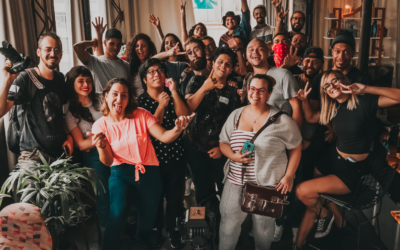*This article originally appeared on ProductionHub, you can view the article here.
Cinematography is a true art form of filmmaking. Just like learning a language, one must be well versed in the “language” of a cinematographer, before they are really able to communicate. Such things as crucial equipment choices, knowing the right locations to shoot, digital vs film, the list can go on, are essential bits of information that seasoned cinematographers know the answers to.
DP Tom Antos is one of those cinematographers.
With over 17 years of VFX and animation experience, as well as the guy behind the YouTube channels, Tom Antos and GALGATV, showcasing his knowledge through his films and his tutorials, he is now sharing his knowledge with us.
Background information
ProductionHUB: How did you get into the biz?
Tom Antos: I started working on films in the 90’s as an animator. First film I worked on was a animated Christmas special, then slowly I transitioned to doing VFX for commercial and finally VFX supervisor on feature films. In 2001 I did my first short film which premiered at the International Montreal Film Festival. I loved creating my own stories so much that in 2002 I decided to quit the animation/VFX industry and start my career as a film director. I started by doing my first feature film as a director called “Under Black Skies.” After that I did lots of music videos to help get my name out there. With time my videos started to gain popularity on YouTube and in 2011 I started to do YouTube tutorial videos and short films as well.
PH: What made you decide to turn to YouTube to showcase your knowledge/tutorials?
TA: As my videos gained popularity on YouTube I kept on getting lots of different people contacting me or leaving comments asking me for help on recreating the same look as I got in my videos. I did my first tutorial in 2009 then a few more in 2010, all of those went viral, so finally in 2011 I decided to spend more time on YouTube and I applied for the YouTube partnership program.
Cinematography Basics
PH: What are some big mistakes you can make before filming? How do you avoid these?
TA: Biggest mistake is not knowing what you want. If you’re a cinematographer or a director you need to know what shots you need for a scene and what look and feel you need. If you don’t know that you will just waste everyone’s time on set while they watch you try different takes before you find something you like. I always start working before the first day of filming by storyboarding and planning as much as I can. I make notes on the types of things I need to have in my shots etc.
PH: Do you have a checklist of things to do before shooting? What’s on that list?
TA: My check list is usually a detailed storyboard of each scene and shot. Next to it I write what to watch out for etc.
Choosing the Right Equipment
PH: How crucial are equipment choices before you begin shooting?
TA: Not very crucial to me. But obviously making a list of gear you own or can borrow/rent will dictate the types of shots you can get. All thought for me I prefer to just shoot with a simple camera and avoid taking too much gear, as I find it often slows me down more then it helps. Lots of gear takes extra time to setup plus carrying gearing in and out of a location can be a hassle.
Great example of what can be done with minimal gear is my last film “Big Wild North”
Also the making of videos about it…
PH: Is there a rule of thumb for the type of camera you should use if you are on a budget?
TA: Yes, if you are working on a low budget production get the smallest and lightest camera you can get that will still deliver the quality you need. Often I see people spend all their money on an expensive and big camera rig but nothing on the actual production and crew, and when you are working on a indie shoot where you have limited crew, time and often no location permits, what you need most is a small camera that allows one person to run around with it and easily swap the lenses etc and also that doesn’t draw too much attention to itself. A pro camera with big lenses, mattebox etc is definitely going to make people stop and look.
PH: What is some of your favorite equipment to use? Why?
TA: My DSLR cameras and a 50mm lens. Reason why I love that combo is because with most dslr cameras these days you can shoot great quality video and the 50mm lens can be used on almost all the time, while still allowing me to tell a story in a cinematic way. Plus a DSLR and most 50mm lenses are small light and easy to work with.
Shooting and Location
PH: How important is location when you are shooting?
TA: Very important. A good looking or interesting location makes any shot look professional. Plus if a location has good available light it makes it easier to make the actors look good as well. One thing I always avoid are locations with plain white walls, that’s a biggest giveaway that it’s an indie production.
PH: How do you determine where you need to shoot, time, etc.?
TA: It’s all based on the story and mood of the scene. Location and time of day produce different qualities of light.
PH: How do you overcome weather conditions that may not agree with your shoot?
TA: I just film even if the weather is not co-operating. Worst thing that will happen, is that I will end up with footage I can’t use and have to re-shoot. But often weather that I thought was not going to work, turns out to actually benefit the final product. Here is one example of such a shoot, where I was planning on shooting a fun summer music video in NYC :
Lighting Techniques
PH: What are some of your favorite lighting techniques?
TA: I like using backlight. Either sun or artificial lights. I find backlighting helps separate the foreground subjects from the background and add 3d dimensionality to the final shots.
PH: Any secrets we may not know about?
TA: Everything in this world is a light source. Often people think to light a scene you need lights or the sun. But everything we see with our eyes reflects photons, that’s why we are able to see it. Therefore if it reflects light it can also be used to light your scene. People often forget that and let unwanted reflected light ruin their shots. I did one tutorial where I talk about that some more:
Achieving the “Perfect Shot”
PH: How do you know when you’ve achieved the “perfect shot”?
TA: I don’t think I’ve ever achieved that. In filmmaking there’s a constant battle between time and quality. If I go past my schedule then I’d rather sacrifice the quality of one shot a bit and move on to get the rest of the shots that I need to complete my project. Even on shoots where I had lots of time to setup each shot, I may be very happy with the final product but months or years later I will look at those same shots and wish I could still change this or that. In the end what’s most important is not to try reach perfection but to actually finish the project.
PH: What are some shots that stand out in your mind?
TA: The one shot that I’m most proud of is the long ONE take I did for the “Famous Movies in 1 Take” video I did with Destorm.
In this video I managed to change the mood of the scene with lights and do it all on que to music while still copying the original look of the films we were mimicking. Plus all of this was done on a super low budget. You can see how I did this here:
Creating a Compelling Show Reel
PH: Do you have any ideas or tips for compiling a show reel that will land you more jobs?
TA: Best show reel you can do to land more jobs is to just do good work and then put it for free for people to see online. In general people don’t like watching demo reels because it’s like watching advertising. Someone is basically trying to advertise themselves. I find the most jobs I’ve gotten is from all the short films and music videos I did and put online. People watch the final product and if they like it they immediately contact me to see if I would like to work with them. Same for when I contact people to work with. I will usually be impressed with a video they did or if it’s a music composer I will stumble upon their music and listen to a few songs in it’s entirety. Problem with demo reels is that aside from someone trying to advertise them selves, it also doesn’t show any whole piece of work, just some quick cuts of the best shots or moments from various projects the person worked on. A lot can be hidden when such editing is used. I personally judge someone’s work by watching a whole film or music video they shot and see how they overall handled the nicer shots but also the quick shots they had to get when they were behind schedule.
PH: What should every show reel showcase?
TA: Contact info! Like I said above, best show reel is your finished work, but also make sure that it’s easy for people to contact you after they watched your films/video/etc. I always put my website address at the end of each film, where I can be easily contacted. I hate when I watch a great film and I want to get in touch with the filmmakers who worked on it but can’t find their contact info, or sometimes even their names in the credits.
CGI in the Cinematography World
PH: What do you think the role of cinematography is today in a world that relies on CGI?
TA: The role of a cinematographer is the same as it’s always been. To capture images that best tell the story. Obivouly if it’s a all CG film where only certain elements or just the actors are real then the role of the cinematographer goes to the VFX team that creates the final image. But even on VFX heavy films, the shots that are mostly or completely live action are the product of the cinematographer. Even if you put in a cool effect into a shot that looks bad, it will still look bad. But that same special effect in a shot that’s well framed and lit will look a lot better.
Digital vs. Film
PH: What are the pros and cons of digital over film?
TA: Pros all go to digital. Film is dead even though some filmmakers are still trying to revive it. I had a chance to work on film early in my career. Including my first feature film “Under Black Skies” and I have to say I’m glad those days are over.
Digital is easier to work with, the media is cheaper. I no longer need to stop a take or the whole production because a film mag needs to be changed or because the gate needs to be checked. Also I can right away see what I shot and judge if I should do a re-take… with film we only had video assist which did not allow to judge the quality of the shot. Plus often a good shot was ruined by someone who mishandled the film in the laboratory afterwards. Lastly digital is cleaner looking then grainy film stock.
PH: Any other tips / words of advice you’d like to provide?
If you’re a young filmmaker who want’s to get better at cinematography or just filmmaking in general, also if you want to progress in your career then the best thing you can do is shoot as many projects as you can. Don’t worry about money. Too often people spend money on gear that they don’t have. Just borrow what you can or buy what you can afford. Also don’t look for just paying gigs when you start out. Often people will turn down jobs just cuz they pay too little or nothing at all. If you have free time and someone is shooting a video and they want to work with you then go for it! It’s like getting a free admission to film school. The locations and actors etc is all arranged for you and you can just shoot and get better at your craft. Best way to learn filmmaking is by doing it… so do it as much as you can. With time you will get a nice collection of work you did that will act as your demo reel plus I can guarantee that some of the people you meet at those no budget shoots will get big and later call you up to work with them on a bigger paying job just because they liked working with you. Too often I get young filmmakers contacting me to hire them but they have nothing to show for their work. Work on as many projects as you can and I will probably contact you myself when I see them.
About Tom Antos

Tom Antos is a director, cinematographer and visual effects artist – all rolled into one. He has worked on some of the biggest feature films, as well as numerous short films and music videos. In addition, he has 17 years of experience in the areas of CGI and classical animation. This work has earned him several awards, including Telly, Promax BDA and Worldfest Gold Remi. Tom’s professional experience ranges from small budget DIY projects to large Hollywood productions like “Bait” (starring Jamie Foxx) and “Everyone’s Hero” (starring Robin Williams and Whoopi Goldberg).
Tom has been sharing his filmmaking experience and knowledge through online tutorials that have gained a large and loyal audience on YouTube. His films and tutorials have been seen over 65 million times on YouTube alone, and his YouTube channels have over 200,000 subscribers and average 2 million views per month.
Tom is embarking on a three-month Workshop Series, where he will be teaching Editing/VFX Sessions and Interactive Master Classes in 27 cities across the United States, Canada, and Europe. The 2-Day Cine School kicks off at the end of February 2016 in Phoenix and continues through its Poland Master Class on May 20th. A full list of locations for the workshop series can be found here.



